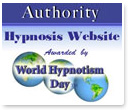
by Charles Curtis
No matter how you have positioned yourself within the field of Hypnosis/NLP, you need to be a master of hypnotic phenomena.
If you’re a hypnotist, then hypnotic phenomena like post-hypnotic suggestions are your bread and butter. And if you’re an NLP practitioner, then everything you do is still within the sphere of hypnosis, whether you’re calling it that or not.
A good review of hypnotic phenomena can be found within the pages of “Hypnotic Techniques 2E” by Arreed Barabasz and John G. Watkins. The book is written for grad students in psychology and medicine who are learning hypnosis, and is very readable if you know your way around psychological jargon (Hardcover, Brunner Routledge, 490 pages, $54.50 publisher’s pricing, discounted on Amazon and other sources).
We decided to use this text this year in our year-long extended course in hypnosis and NLP, and it has worked out very well. It’s not a text in the subtleties of Ericksonian distinctions, (there are better books if that’s your focus, some of which we use when we get to the Ericksonian part of our course), but if you want honest-to-God, down to earth focus on basic hypnosis techniques and how they operate, this book does a very nice job.
One of the things the book does well is document some of the many political twists and turns in the hypnosis field, especially the conflict between those who have steadfastly maintained the “non-state hypothesis” that is, “hypnosis doesn’t involve any particular state” versus the vast majority of hypnotists who feel that trance is an observable phenomenon that involves a particular state of mind.
Since Barabasz has been deeply involved in academic research, and is a staunch defender of the state hypnothesis, he has a lot to say on the subject, especially why he disagrees with the non-state hypothesis, all of which I found quite interesting. Now that brain scans are beginning to be used in hypnosis research, that debate is getting even more interesting.
Every practitioner has his/her own favorite definition of hypnosis. Bandler and Grinder, the developers of NLP, used to take opposing sides of the “nothing is hypnosis” vs “everything is hypnosis” debate during trainings. If we were to have a debate on “what is hypnosis”, things would probably get pretty lively pretty quickly, as people tend to passionately defend their favorite choices.
As an NLP practitioner and meditation teacher trained to look for subtle distinctions, my definition of hypnosis is fairly simple and very broad: “A state of focused attention”, with the overall experience including not only what you are focused on, but what you are simultaneously not focused on, that is, what you are consciously dissociated from.
To me this means any time you’re not paying attention to all of your experience, which means anytime you’re not in what meditation teachers call “beginner’s mind”, which is when your consciousness is wide open and you’re simply open to all of life, without filtering. By this definition, most people are in some level of trance most of the time.
This then allows me to look for and find hypnotic phenomena in a large variety of every-day circumstances, which most normal people would not define as hypnotic, as they do not involve stereotypical images of trance. This would include such things as normal conversation, reading anything, paying attention to anything, and any thought process.
How can normal every-day stuff like this be hypnotic, you question, as deep trance phenomena do not seem to be present. But if you think about it, is that true? Just consider for a minute one of the most normal activities of current social life, that of texting someone on your cell phone. Do that while being a professional subway motorman, running a subway train in a busy city system, and the next thing you know, you’re crashing into another train.
How could a professional motorman, whose only job is to drive a train safely and who is trained to do so and is experienced in how to do that, ignore a train looming right in front of him and drive right into it at high speed? Well if he’s in the deep trance of cell-phone-texting, it’s quite possible, and it happened not too long ago, causing a terrible crash, and spawning a wave of anti-texting laws. No, we don’t call it trance, we call it “distracted driving”, but to a hypnotist, this is nothing more and nothing less than deep trance phenomena pure and simple.
Because, let’s face it, you don’t need a 20-minute induction to get trance. We all tell our clients about the “natural trance” of spacing out at a traffic light, and how long of an induction does that take? All it takes is the split second to get caught up in your thought process, and the next thing you know somebody is honking behind you, and you suddenly realize your attention was a million miles away.
So now you may begin to realize that the title of this article is a trick question, because I’m about to make the case that trance phenomena are everywhere, that is, that we’re all really good at that. When we get trained to notice and utilize this, we become much better hypnotists and NLP Practitioners.
Let’s look at the list of hypnotic phenomena as defined in “Hypnotic Techniques”: motor behavior, influencing attitudes, alteration of perceptions, influencing autonomic processes, influencing mood and affect, influencing cognition, post-hypnotic amnesia, hypermnesia, regression, dissociation, altering subject-object relationships, time distortion, altered state, and altered interpersonal relationship.
Because Barabasz is an academic researcher, he gives examples and photos of these phenomena as produced in the laboratory under research conditions. But let’s see if we can find evidence of each one of these in every day life.
MOTOR BEHAVIOR
Give someone a suggestion in trance that will result in a movement of a body part (motor movement) and that person will typically begin moving their body in the suggested way. This is utilized in techniques like the pendulum and finger signaling, both examples of “ideomotor” movements (idea-induced motor movements).
But how often does this happen spontaneously? I saw a slam poetry event on Saturday night, which involved street dance and the artistic form of pole dancing, interspersed with very animated and emotional recitations of street poetry. As we sat there waiting for the program to begin, music was playing that was like rap music without the rap.
A little girl sitting a few rows away from me was moving happily with the music as soon as she came in, smiling and moving her body rhythmically in a way that was a delight to watch. This was a very lovely example of the common example of how music that we like puts us instantly in trance and elicits motor movements.
INFLUENCING ATTITUDES
Post-hypnotic suggestion is remarkable when you see it done to an exaggerated degree, such as in a hypnosis stage show or hypnosis demonstration. But any time we suggest to someone that they do something, and they are in a suggestible state of mind (meaning that we have rapport with them), they will tend to carry out the suggestion. This happens all the time in normal everyday conversation and is another example of post-hypnotic suggestion.
In other words, has someone ever suggested that you do something, and even though you weren’t going to do it, once they said it, you got up and did it anyway? Well, there you go, suggestion given and accepted!
ALTERATION OF PERCEPTIONS
You can suggest to a hypnotic subject that it’s really cold and they’ll start shivering, or that it’s really hot, and they’ll want to remove an outer garment of clothing.
Makes a fun stage show or useful demonstration. But doesn’t this happen all the time? Has anybody ever said to you “It’s getting cold in here” and you were having so much fun that you hadn’t noticed until they suggested it to you, but now it seems cold to you too? Now did you come out of your trance, go into their trance, or get in touch with “reality”? It seems like you got in touch with “reality”, but perception of sensory input is relative and changeable, and hypnotic suggestions always seem like “reality” when they are accepted, and you might have continued enjoying yourself for quite some time without having the thought, perception, and experience of “It’s chilly”. So what do you think, trance phenomena? I think so.
INFLUENCING AUTONOMIC PROCESSES
We all know the “lemon test” for hypnotic suggestibility testing. But when someone says “God, I’m hungry, how about you”, and all of a sudden you’re feeling hungry and noticing physiological evidence of such, when a moment ago you were caught up in what you were doing and had no evidence of hunger within your perception, what just happened?
Once again, did you enter their trance of hunger, come out of your trance that did not include hunger, or come into contact with a reality that you are hungry?
This also shows us that all phenomena happen on a continuum. Deprive someone of food long enough, and s/he will enter a strong hunger state that is undeniable. But we often eat for emotional reasons, thinking we are hungry, when instead we’re distracting ourselves from uncomfortable feelings. This is an important component of weight loss hypnosis, ferreting out these unconscious patterns, and making them conscious, and then shifting them so the stimulus response-pattern now works differently.
“God, those donuts look good! I shouldn’t, but I’m going to.” Happens all the time!
INFLUENCING MOOD AND AFFECT
The stage hypnotist says “you’re feeling happy, happy, happy” and the natural somnambulists on the stage need no more suggestion to smile broadly and go with the program. The hypnotist says “go back to a time when you last felt that emotion and tell me what’s going on, that’s right, and what is the part of that experience that is most strongly influencing how you feel?” and before you know it, the client is deep in somnambulism, reliving an old memory.
But how often does that happen in normal conversation? Hearing “our song”, catching a whiff of a favorite scent, having somebody say “remember when” and off we go, into spontaneous regression, which then instantaneously affects our mood and affect.
Ever seen someone instantaneously thrown back into the unprocessed memory of a loved-one’s death, and all of a sudden they’re dissociated from their present experience and crying? Happens all the time.
INFLUENCING COGNITION
In cognitive therapy we use Socratic logic to show clients that a given thought/feeling/behavior is different than they thought it was. This can be used artfully in reframing, which then immediately changes behavior. For example, the hypnotist can show his stop-smoking client that “my first cigarette of the day” is not “heavenly, something I live for” but the cause of all his trouble, his hacking and coughing, his loss of lung capacity, and the future source of that unwanted spot on the lung, and all of a sudden it doesn’t seem so heavenly.
Have you ever watched a political debate? If you have strong political opinions, watching a few minutes of such a debate will influence your cognition big-time in a big hurry, and when something controversial happens, in a split second you’re in a strong trance state of focused attention. Or for those of you into team sports, how trance inducing is that TV in the sports bar or in your living room? It would take an earthquake to get your attention under such deep trance conditions.
POST-HYPNOTIC AMNESIA
Yes, it’s riotously funny when the stage hypnotist makes someone forget their first name, but have you ever walked out of the room to get something and the instant you go through the door you forget what it is you were going to look for?
Well, welcome to the world of post-hypnotic amnesia. Walk back into the room you just came out of, and you’ll drop back into that room’s trance, and you’ll remember what it is you’re looking for, and this time you’ll bring it into your conscious mind and you won’t forget it this time, will you, that’s right, you won’t, you tell yourself, as you give yourself a hypnotic suggestion before walking out the door again.
Unless of course, you’re obsessive-compulsive, and you’re forgetting whether you locked the door, and you go back and check the door five times, in which case you are going in and out of amnesia again and again within a few seconds of time.
But even a normal person can become distracted (dissociated) and say, “Wow, today, I’m having a hard time concentrating, I keep losing my train of thought, I need a break!” Happens all the time.
HYPERMNESIA AND REGRESSION
Hypermnesia is recalling memories in unusual and unexpected detail. If you do regression work for a living, this is your bread and butter.
But have you ever been somewhere, doing something, and an old memory gets triggered by a spontaneous stimulus-response, and you say to yourself or to someone else “Why, I hadn’t thought of that in years. God, for a moment I felt like I was almost there.”
This can be fun, but sadly, those with PTSD, phobias, and other triggerable dysfunctional states aren’t ALMOST there, they feel like they’re REALLY there, back in ‘Nam, or these days, Iraq, and they get a HUGE affect change as they shift, in a split second, into a deep and painful trance state. They’re WAY too good at recycling those old memories.
So yes, hypermnesia and regression, everywhere you look.
DISSOCIATION
Extreme dissociation at unwanted times and places is a pathology, yet lesser degrees of dissociation are something we can produce at will for positive reasons as NLP practitioners when carrying out many NLP patterns.
But have you ever forgotten where you put your keys, lost your train of thought, or felt yourself shifting out of rapport with the person you’re talking to because they said something upsetting?
Welcome to the world of everyday dissociation.
ALTERING SUBJECT-OBJECT RELATIONSHIPS
That’s a kind of dissociation such as feeling that your arms and legs are not part of you, but just there. This sort of thing is easily creatable in the formal hypnotic state, and can be used to advantage both in stage work and also in the hypnotic context.
Depersonalization is an extreme pathological degree of this, no doubt. But have you ever said to someone else “I don’t feel like myself today” or “That goal has seemed really far away, but now that I think about it this way, it seems much closer?”
Like I said, it’s all on a continuum, and part of everyday life.
TIME DISTORTION
It happens all the time. We can’t wait for something to be over, and it drags out. Or in contrast, we’re enjoying the movie intensely, and before we know it, it’s over, and sometime later, we can’t even, for the life of us, remember what that felt like.
Like I said, happens all the time.
INTERPERSONAL RELATIONSHIPS
There is no subject more filled with altered states than interpersonal relationships. We are constantly triggered into altering our states by the actions of others, while at the same time we are triggering them, sometimes consciously, most of the time unconsciously.
Sometimes it’s good, like feeling joy at the sight of a loved one’s face, and sometimes conscious and deliberate, like a surprise party, but most of the time it’s unconscious and often not working too well.
So these are trance states that often don’t serve us.
THE ERICKSONIAN HYPNOTIST
The Ericksonian hypnotist is trained to utilize, utilize, utilize.
So you don’t get your subject into trance, you utilize the trance your subject walks in the door with, and then shift him/her into more useful trances that trigger behaviors s/he wants more than the old ones.
CONVERSATIONAL HYPNOSIS
Once you learn that trance is present all day, every day, you can learn conversational hypnosis, how to do the most elegant trance work without even stopping to induce formal trance. And it’s so much fun to do this, and so life altering, and so effective, because the client can’t resist a trance induction he doesn’t know is going on.
TRANCE IS A CONTINUUM
So you get the point – trance is all around us all the time. Trance is going on 24/7 in our experience, deep trance can be induced in an instant, and when you look, it is easy to find trance phenomena everywhere you go.
In other words, we’re all very good at trance phenomena. And the sooner we realize that this is true, the better we’ll get at both formal trance such as NLP patterns and hypnosis techniques, and informal trance such as powerful conversational methods.
ALTERED STATE
If you’re getting the general impression that I’m asserting that life itself is an altered state, you’re on the right track.
Now altered means it has to be different from another state that is the reference point, so I’m going to say that for my purposes here today, it’s simply altered compared to the state you were in before.
So life is a continuum of passage from one altered state to the next altered state to the next altered state, all day long.
So maybe, if you look at it that way, all of life is trance? Hmmm, isn’t that an interesting and different way of looking at things!






